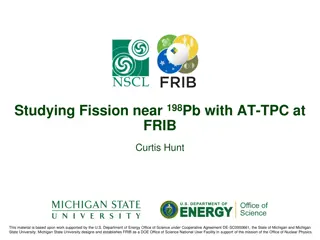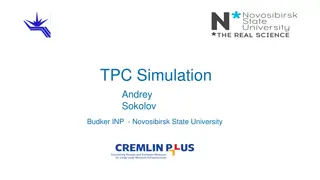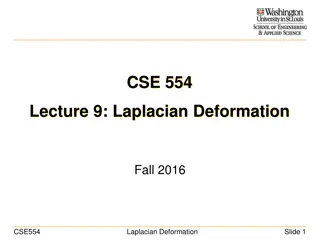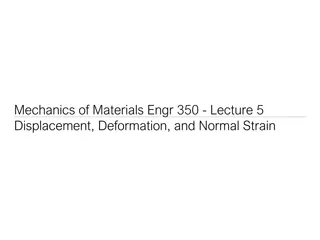Fission Near 198Pb with AT-TPC at FRIB: Insights from Curtis Hunt
Delve into the intriguing world of fission studies near 198Pb using the AT-TPC at FRIB. Supported by the DOE Office of Science, this research probes nuclear structure, fission properties, and fusion-fission reactions. By employing innovative techniques like the Heavy Isotope Tagger and active target
4 views • 39 slides
Advanced Technology in Dark Matter Research
Cutting-edge technologies such as multi-source TPB evaporation, LAr TPC, and DarkSide-20k TPC are being utilized in the study of dark matter. These technologies aim to enhance detection sensitivity and uniformity in film coatings, crucial for advancing our understanding of mysterious dark matter par
7 views • 20 slides
TPC Mechanical Support Considerations for ILD Integration Task Force Meeting
During the ILD Integration Task Force meeting, discussions revolved around the deformation of the TPC under weight and pressure, fixation points for hanging the TPC, considerations for supporting the TPC with the Cryostat or HCAL, and dealing with potential service clashes. Challenges and preference
0 views • 5 slides
Axial Deformation in Mechanics of Materials
In the study of mechanics of materials, axial deformation is analyzed by simplifying real structural elements. This approach involves approximations that are generally satisfactory and work due to factors like allowable stress design, factor of safety, and statistical analysis of strength. Saint-Ven
4 views • 9 slides
Production in Collisions at 8-16 TeV: Analysis Overview
Detailed analysis overview of the production in collisions at 8-16 TeV incorporating contributions from Pavel Larionov (ITSsa), Paula Matuoka (TPC), Silvia Pisano (TPC), and Marco Toppi (TOF). The analysis involves the comparison of spectra data to previous datasets, emphasizing the importance of un
4 views • 50 slides
Electroluminescence Time Projection Chamber (EL TPC) Physics
Delve into the fundamentals of Electroluminescence Time Projection Chambers (EL TPCs) through concepts like electron drift, scintillation mechanisms in noble gases, and charge yield estimation. Explore the workings of EL TPC prototypes, such as ZEPLIN II/III and DarkSide, for applications like react
0 views • 23 slides
Cutting-Edge TPC Simulation Techniques at Budker INP & NSU
Cutting-edge TPC simulation techniques implemented by researchers at Budker INP and NSU include framework implementations, event displays, background simulations, track distortions, and gas medium simulations. Researchers like Andrey Sokolov, Lev Shekhtman, Vijayanand KV, and Timofey Maltsev have co
4 views • 15 slides
Efficient Dynamic Skinning with Low-Rank Helper Bone Controllers
This research explores efficient dynamic skinning methods using low-rank helper bone controllers to achieve robust, simple, and high-performance skin deformation in computer graphics. By investigating linear blend skinning techniques and helper bone rigs, the study aims to address the wishlist of ga
2 views • 29 slides
Laplacian Deformation in Engineering and Applied Science
Laplacian deformation is a technique used in non-rigid registration to account for shape variance and improve fitting between source and target shapes. This method involves minimizing the distance and distortion terms to achieve accurate alignment. Intrinsic and extrinsic methods are discussed, wher
1 views • 53 slides
Advances in ILD Detector Design and TPC R&D
Explore the latest developments in ILD detector optimization and TPC research, focusing on enhancing event reconstruction accuracy and energy resolution. Learn about the ILD concept based on particle flow, the ILD group activities, organizational structure, technical advancements, and TPC readout te
2 views • 22 slides
R&D and Simulations on Gain Stability and IBF for ALICE GEM-TPC Upgrade
The research and development efforts, along with simulations, focus on enhancing gain stability and addressing issues related to Ion Back Flow (IBF) for the ALICE GEM-TPC upgrade. Detailed outline, status updates, and major challenges are discussed, highlighting the significance of the upgrade for i
4 views • 24 slides
Overview of ICARUS LAr-TPC Installation and Testing
Detailed overview of the installation and testing procedures for the ICARUS Liquid Argon Time Projection Chamber (LAr-TPC) readout electronics. The system comprises front-end amplifiers, ADC systems, optical links for data transmission, mini-crates housing the electronics boards, power supplies, and
1 views • 6 slides
Thermal and Mechanical Simulation of Beryllium Window for MICE 201 MHz Cavity
Conducted thermal and mechanical simulations using TEM3P for the beryllium window of the MICE 201 MHz cavity. Analysis focused on temperature distribution, frequency shifts, thermal deformation control, and stress considerations under varying operation conditions and material properties. Detailed in
1 views • 11 slides
Detector Safety System (DDSS) for TPC Electronics and Connections to Slow Controls
The Detector Safety System (DDSS) for TPC Electronics involves multiple protection levels including slow controls, PLC-based systems, and fuses/diodes to ensure detector safety. It's crucial to consider these aspects during the design phase as modifications post-design are challenging. The system, d
5 views • 20 slides
Aeroelasticity: Deformation and Aerodynamic Forces
Aeroelasticity explores the intricate relationship between the deformation of elastic structures in an airstream and the resulting aerodynamic forces. This field of study is vital for predicting and managing interactions between structural mechanics and aerodynamics in aircraft design. Historical in
4 views • 15 slides
Final Design of ILD Detector TPC - Towards Improved Performance
The final design of a Time Projection Chamber (TPC) for the ILD detector is detailed in this report, showcasing advancements made from 2007 to 2014. The project, D_RD9, focuses on addressing engineering challenges such as electronics, cooling, and software to enhance the TPC's feasibility and functi
0 views • 17 slides
Insights on TPC Optimization for Particle Detection
Explore the optimization of Time Projection Chambers (TPC) for particle detection through discussions on basic reconstruction, charge resolution, detector parameters, wire pitch, signal processing, deconvolution techniques, and noise analysis. Gain valuable insights on field and electronics response
4 views • 28 slides
Basics of Metal Forming Processes
Metal forming processes play a crucial role in shaping products, with casting, machining, joining, and deformation being the primary methods. Each process has its advantages and limitations, catering to different needs for accuracy, material wastage, complexity, and production quantities. Understand
1 views • 22 slides
Update on TPC Electronics Activities - July 2019
The upcoming short-term activities for ICARUS WA104 meeting on July 17th, 2019, at TPC Electronics include installation of cables, refurbishment of defective modules, and addressing excess noise issues in mini-crates. Detailed plans for interventions at FNAL from July 24th onwards involve repair act
0 views • 7 slides
Displacement, Deformation, and Normal Strain in Mechanics of Materials
Displacement and deformation in materials play a crucial role when loads are applied, leading to normal strain. This lecture discusses the concepts of displacement, deformation, and strain, covering topics such as types of strain, strain units, normal strain calculations, and the orientation of norm
3 views • 7 slides
Speckle Tracking Echocardiography Basics
Speckle tracking echocardiography is a method analyzing speckle artifacts in ultrasound images to obtain information on myocardial motion and deformation. By tracking speckles in the ventricle wall, parameters like motion displacement, velocity, strain, and strain rate can be measured. Deformation c
2 views • 12 slides
Impact of TPC Coupled to DSC for Legacy Fairness Issue
Legacy fairness is crucial for 11ax networks. This submission explores the use of TPC coupled to DSC to address the legacy unfairness issue and maintain system gain while ensuring fairness in SS3. The study evaluates how increasing Tx occasions and desired Rx occasions can recover legacy fairness fo
2 views • 20 slides
Tiling of Pixel TPC and Read-Out: Solutions for Maximum Efficiency
In these images and descriptions, the tiling of the Pixel TPC for ILD by Peter Kluit is showcased. The Quad, with specific dimensions, forms the basic building block of the read-out. Various solutions are proposed to maximize the number of quads per row while avoiding insensitive areas at module edg
3 views • 6 slides
Tools for Centrality Measurements at MPD
This study examines centrality measurements at the MPD using tools like TPC/TOF in the participant region and FHCal in the spectator region. It explores two approaches for measurements and their combination, along with simulations for TPC and FHCal. Ambiguities in centrality measurements are address
3 views • 13 slides
Insights into TPC Gas System at LCTPC Collaboration Meeting, DESY 2017
This content provides detailed insights into the TPC gas system discussed at the LCTPC Collaboration Meeting held at DESY in 2017. Topics covered include physics-related requirements, TPC volume, pressure-temperature considerations, gas sensors, absorbers, and eco-friendly alternatives for CF4 relea
1 views • 13 slides
IEEE 802.11-16/0403r1 Spatial Re-Use Adaptive CCA Simulation Results
Presentation discussing simulation results on open loop OBSS_PD adjustment and transmit power control in IEEE 802.11-16/0403r1, including methods for adjusting OBSS_PD levels and implementing suitable TPC. The study focuses on static OBSS_PD adjustment, balanced OBSS_PD adjustment with TPC, RSSI-bas
2 views • 9 slides
Laplacian Deformation in Engineering and Applied Science
Explore Laplacian deformation techniques in the context of non-rigid registration at Washington University in St. Louis, School of Engineering and Applied Science. Learn about rigid-body transformations, iterative improvement methods, intrinsic vs. extrinsic registration, and more. Discover how non-
0 views • 53 slides
TPC and Blue Label Acquisition of Control: Public Hearing Insights
Gain insights into the public hearings regarding the acquisition of control by TPC and Blue Label, including discussions on the importance of public hearings, concerns about confidentiality, and the public interest in the matter.
2 views • 10 slides
Decision on TPC vs DC for CEPC Detector Performance Comparison
Explore the decision-making process for choosing between Time Projection Chamber (TPC) and Drift Chamber (DC) for the CEPC detector based on performance comparison, cost estimation, and a mini-review exploring feasibility and critical R&D priorities.
1 views • 17 slides
TPC Digitization Migration Overview
Explore the migration process of TPC digitization in CEPCSW, including the conversion of data formats, utility package migration, and more details on the migration source code and requirements.
2 views • 6 slides
TPC/Cell.C Transaction and HDG/BBBE Ownership Evolution
Explore the complexities surrounding the TPC/Cell.C transaction and the evolution of HDG/BBBE ownership in Cell.C. Insights reveal challenges like incomplete applications, ownership thresholds, trust requirements, and recommendations for compliance.
1 views • 7 slides
Optimizing TPC Meeting Logistics for Efficient Paper Discussions
Enhance the efficiency of TPC (Technical Program Committee) meetings by utilizing conflict resolution slides, guiding TPC leads, and emphasizing confidentiality. Tips include concise paper summaries, detailed discussion summaries, and positive feedback. Maintain focus during discussions and respect
1 views • 9 slides
IEEE 802.11-16/1567r5 TG.ax Inter-BSS Traffic Handling Proposal
This content explores a proposal for handling inter-BSS traffic in an IEEE 802.11-16/1567r5 TG.ax context. The document discusses Dynamic Sensitivity Control (DSC) and Transmit Power Control (TPC) mechanisms along with responses to comments. Various schemes for Spatial Reuse are presented, including
7 views • 22 slides
Simulation Results of Spatial Reuse in IEEE 802.11-16 Environment
Explore the impact of Dynamic Sensitivity Control (DSC) and Transmit Power Control (TPC) on spatial reuse in wireless networks. The study evaluates various Modulation and Coding Schemes (MCSs) to optimize performance and reduce interference, crucial for maximizing throughput. Dive into the details o
1 views • 13 slides
IEEE 802.11-16/0350r0: TPC and DSC for Enterprise Scenario
Explore the implementation of Transmit Power Control (TPC) and Dynamic Sensitivity Control (DSC) in an enterprise scenario for IEEE 802.11. The presentation delves into the impact on spatial reuse and performance optimization for stations in close proximity to access points.
2 views • 13 slides
Understanding Nuclear Deformation and Shape Determination
Dive into the intricate world of nuclear physics as we explore the challenges and techniques involved in determining prolate or oblate shape through low-energy inelastic scattering. Discover the significance of nuclear deformation and the complexities of deciphering the sign of deformation. Unravel
2 views • 15 slides
Modeling Active Crustal Deformation with Tdefnode
Explore the Tdefnode software developed by M. A. Floyd at Massachusetts Institute of Technology for modeling active crustal deformation. Learn about its concepts, commands, possible inputs and outputs, along with where to download the source code. Discover how Tdefnode can incorporate various source
1 views • 10 slides
Tiling Solutions for Pixel TPC Read-Out Modules
Explore the tiling strategies and solutions for the Pixel TPC read-out modules with detailed examples of simple and complex configurations. Learn about quad placement, insensitive areas, and guard structures for optimal performance in particle detection systems.
3 views • 36 slides
TPC Assembly Volker Prahl, Thomas Schröner-Sadenius Paris
Explore ideas and considerations for TPC assembly discussed at the event in Paris, including the location, assumptions, and vertical assembly procedures in the AH hall. The discussion covers space requirements, grey-room creation, field cage delivery, and end-plate mounting, offering a detailed insi
1 views • 40 slides
Deformation of Cu-Pd-P Metallic Glass Study
Explore the deformation behavior of Cu-Pd-P metallic glass under cyclic mechanical load during continuous heating. This research project involves modeling and experimenting with the plastic flow of a Co-based amorphous alloy subjected to dynamic loading conditions. Tasks include suggesting and verif
0 views • 9 slides




































